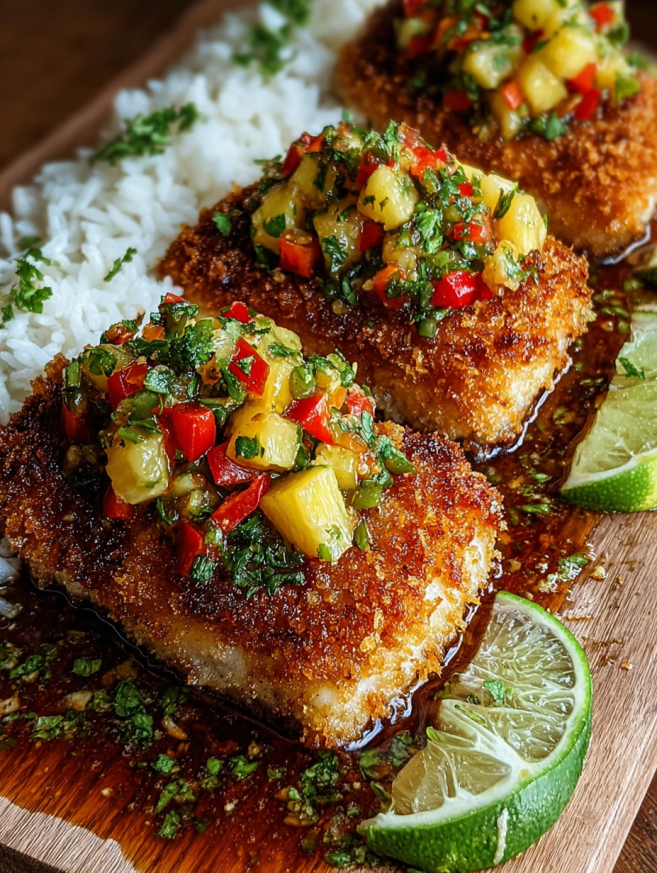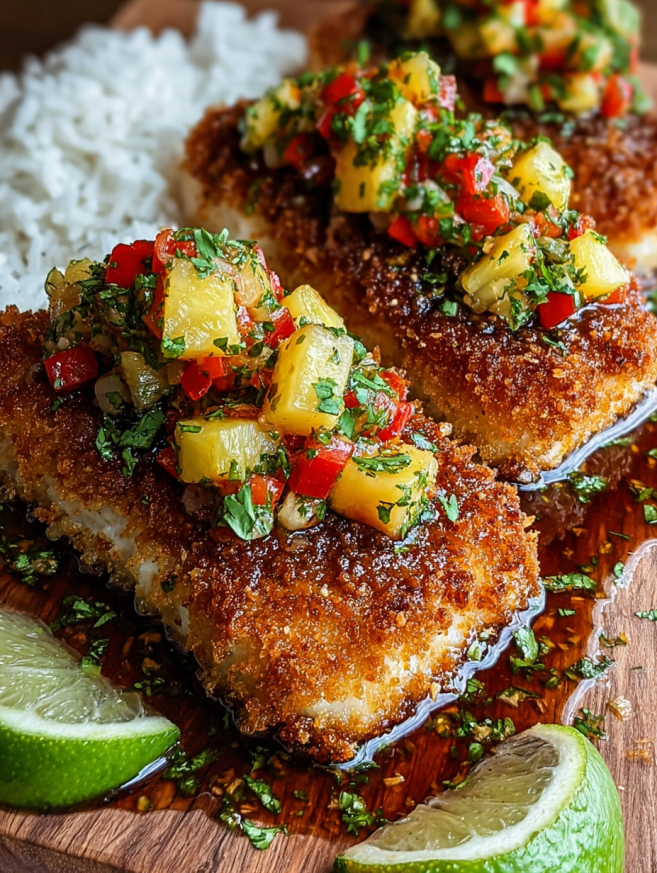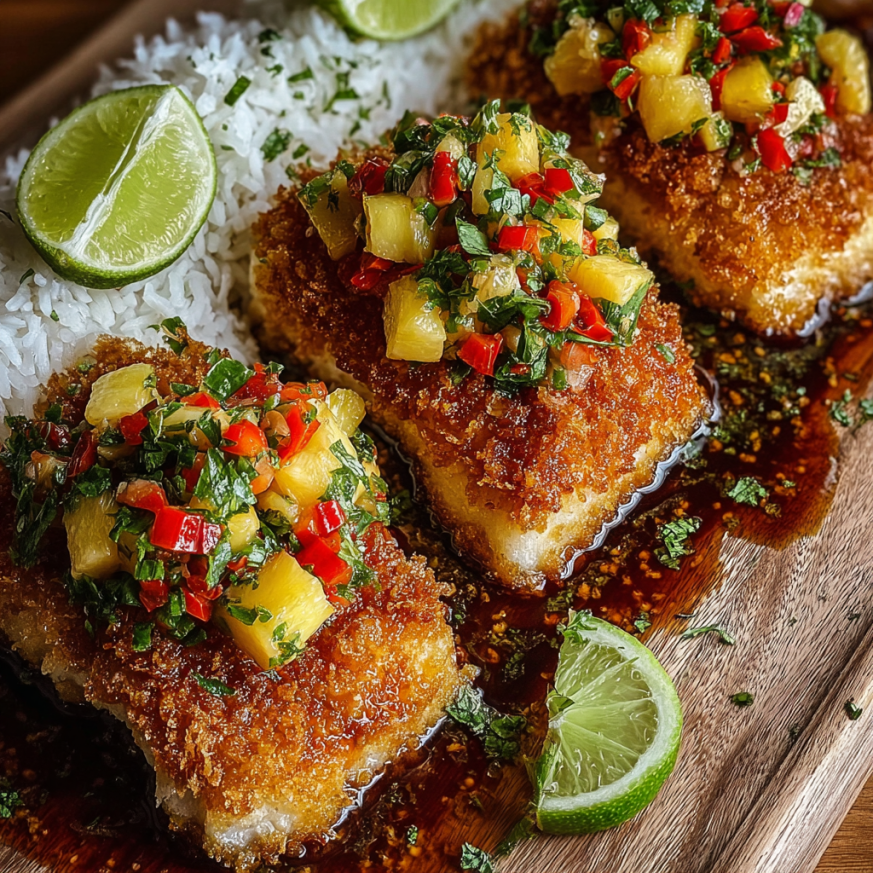Prep Time: 20 minutes
Cook Time: 15 minutes
Total Time: 30 minutes
Servings: 4
The first time I made this dish was for a dinner party where I wanted something impressive but not intimidating. As I pulled those golden-crusted salmon fillets from the oven, the tropical aroma filled my kitchen and instantly transported everyone to a beachside café. My neighbor, who claims she “doesn’t do fancy cooking,” asked for the recipe before she’d even taken her first bite. That’s the magic of this dish—it looks and tastes like something from a high-end restaurant, yet it comes together in just thirty minutes with straightforward techniques.
What makes this recipe truly special is the contrast of textures and flavors. The crispy coconut crust provides a satisfying crunch that gives way to tender, flaky salmon underneath. Meanwhile, the bright pineapple salsa cuts through the richness with its tangy sweetness and subtle heat from jalapeño. It’s a complete sensory experience that somehow feels both indulgent and refreshing at the same time.
Why This Tropical Salmon Will Become Your Go-To
Restaurant-quality results without culinary school training make this recipe accessible to home cooks of all skill levels. The breading station setup might seem fancy, but it’s actually a foolproof method that ensures even coating every time. I’ve taught this technique to friends who’d never breaded anything before, and they nailed it on their first attempt.
Healthy omega-3s meet tropical flavor in a combination that actually makes eating well exciting. Salmon is packed with heart-healthy fats and protein, while the fresh salsa adds vitamins and fiber without heavy sauces or creams. You’re getting a nutritionally complete meal that doesn’t taste like diet food whatsoever.
Two cooking methods offer flexibility depending on your preference and equipment. Baking creates a hands-off approach that’s perfect for entertaining, while pan-frying delivers even more golden crispiness if you have a few extra minutes. Both methods produce delicious results, so you can choose based on your schedule and mood.
The salsa elevates everything and can be made while the salmon bakes, maximizing efficiency. Fresh pineapple brings natural sweetness, red bell pepper adds crunch, and jalapeño provides just enough heat to keep things interesting. The best part? This salsa tastes even better after sitting for 20-30 minutes, making it ideal for prep-ahead situations.
Impressive presentation requires minimal effort, which is exactly what you want when hosting dinner guests. The golden coconut crust looks stunning against the pink salmon, while the colorful salsa adds vibrant pops of yellow, red, and green. Simply plate it, top with salsa, and watch your guests pull out their phones to photograph their meal.
Ingredients You’ll Need
For the Coconut Crusted Salmon
- 4 salmon fillets (6 oz each) – Look for thick, center-cut pieces with consistent thickness for even cooking
- 1 cup unsweetened shredded coconut – Avoid sweetened varieties which can burn and taste overly sugary
- 1/2 cup panko breadcrumbs – These Japanese-style breadcrumbs create extra crispiness
- 1/4 cup all-purpose flour – Forms the base layer that helps everything else adhere
- 2 large eggs – Acts as the binding agent between flour and coconut coating
- Salt and pepper to taste – Essential for seasoning each layer
- 2 tablespoons coconut oil – Complements the coconut crust and provides healthy cooking fat
For the Fresh Pineapple Salsa
- 1 cup fresh pineapple, diced – Fresh is crucial here; canned pineapple is too soft and lacks brightness
- 1/2 red bell pepper, finely chopped – Adds sweet crunch and beautiful color
- 1/4 cup red onion, finely chopped – Provides sharp, fresh bite
- 1 jalapeño, seeded and minced – Brings gentle heat; adjust to taste
- Juice of 1 lime – Essential acid that brightens all the other flavors
- 1/4 cup fresh cilantro, chopped – Adds herbaceous freshness
- Salt to taste – Enhances and balances the natural sweetness
Step-by-Step Instructions
Create the Vibrant Pineapple Salsa
Start by preparing your salsa so the flavors have time to develop while you focus on the salmon. In a medium bowl, combine the diced fresh pineapple, finely chopped red bell pepper, red onion, and minced jalapeño. Squeeze the lime juice over everything, then add the chopped cilantro and a pinch of salt. Stir gently to combine all ingredients, then set aside at room temperature. The acid from the lime will begin to soften the onions slightly while all the flavors marry together beautifully.
Preheat Your Cooking Equipment
For baked salmon, position your oven rack in the center and preheat to 400°F (200°C). Line a baking sheet with parchment paper or lightly grease it with cooking spray to prevent sticking. If you’re opting for the pan-fried method instead, place a large skillet over medium heat and add the coconut oil, allowing it to warm while you prepare the breading station.
Set Up Your Breading Station
Arrange three shallow bowls or plates in a row on your counter—this assembly line makes the coating process smooth and efficient. In the first bowl, add the all-purpose flour seasoned generously with salt and freshly ground black pepper. The second bowl should contain your whisked eggs, beaten until the yolks and whites are completely combined. In the third bowl, mix together the unsweetened shredded coconut and panko breadcrumbs until evenly distributed.
Master the Breading Technique
Pat your salmon fillets dry with paper towels—this crucial step ensures the coating adheres properly. Take one fillet and dredge it completely in the seasoned flour, turning to coat all sides. Gently shake off any excess flour, as too much will create a gummy layer. Next, dip the floured fillet into the beaten eggs, allowing the excess to drip back into the bowl for a few seconds.
Apply the Coconut Crust
Transfer the egg-coated salmon directly into the coconut-panko mixture. Press down gently with your hands, then flip and repeat on the other side, ensuring complete coverage. The key is to press firmly enough that the coating adheres but not so hard that you crush the delicate salmon flesh. Place the fully breaded fillet on a clean plate and repeat this process with the remaining three fillets.
Baking Method for Hands-Off Cooking
Arrange your breaded salmon fillets on the prepared baking sheet, leaving about 2 inches of space between each piece for air circulation. Slide the pan into your preheated oven and bake for 12-15 minutes, depending on the thickness of your fillets. The salmon is done when it flakes easily with a fork and reaches an internal temperature of 145°F. The coconut should turn a beautiful golden brown, though if it’s browning too quickly, tent the pan loosely with foil for the last few minutes.
Pan-Frying Method for Extra Crispiness
Once your coconut oil is shimmering but not smoking, carefully place two fillets in the skillet—don’t overcrowd, as this reduces the temperature and prevents proper browning. Cook undisturbed for 4-5 minutes until the bottom develops a deep golden crust. Using a thin spatula, carefully flip each fillet and cook the second side for another 4-5 minutes. Transfer the cooked salmon to a paper towel-lined plate while you cook the remaining fillets, adding more oil if necessary.
Plate and Serve with Flair
Transfer each coconut crusted salmon fillet to individual serving plates or arrange them on a large platter for family-style service. Spoon generous portions of the pineapple salsa directly over the top of each fillet, allowing some to cascade down the sides. The colorful salsa against the golden crust creates a stunning visual contrast that makes this dish truly restaurant-worthy.

Serving Suggestions for a Complete Meal
Steamed jasmine rice makes an ideal accompaniment, as its subtle fragrance complements the tropical flavors without competing. The fluffy rice also helps soak up any juices from the salsa, ensuring nothing goes to waste. For a lower-carb option, cauliflower rice seasoned with lime zest works beautifully and maintains the light, fresh theme.
A crisp green salad dressed with a citrus vinaigrette balances the richness of the salmon perfectly. Mix baby spinach, arugula, and butter lettuce with thinly sliced cucumber and avocado. The peppery greens and creamy avocado create textural variety while the acidic dressing echoes the brightness of the pineapple salsa.
Consider serving coconut rice to double down on the tropical theme. Simply cook your rice in a mixture of coconut milk and water, adding a pinch of salt. The subtle coconut flavor throughout the meal creates a cohesive dining experience that feels purposeful and well-planned.
Grilled or roasted asparagus spears provide an elegant vegetable side that looks as good as it tastes. The slight char from grilling adds another layer of flavor complexity, while the asparagus’s natural earthiness grounds the tropical elements. Drizzle with a bit of lime juice to tie everything together.
For entertaining, serve this as part of a tropical-themed dinner party alongside coconut mojitos or pineapple margaritas. Set the table with bright colors and tropical flowers for an immersive experience. Your guests will feel like they’ve been transported to a beach resort without leaving your dining room.
Creative Variations to Try
Asian-Inspired Twist
Replace the pineapple salsa with a mango-cucumber salsa and add sesame seeds to the coconut crust. Drizzle with a sweet chili sauce or sriracha mayo for heat. This variation brings Southeast Asian flavors to the forefront while maintaining the crispy coating everyone loves.
Spicy Caribbean Version
Add cayenne pepper and jerk seasoning to your flour mixture for a spicy kick. Top with a papaya-habanero salsa instead of pineapple for authentic Caribbean heat. Serve with black beans and rice for a complete island-inspired feast.
Cilantro-Lime Cream Sauce
For those who aren’t fans of chunky salsa, blend the pineapple salsa ingredients with Greek yogurt or sour cream to create a smooth, creamy sauce. This maintains all the tropical flavors while offering a different texture profile that some diners prefer.
Almond-Crusted Alternative
Substitute finely chopped almonds for half the coconut to create a nuttier crust with extra protein. This works especially well for those who find pure coconut crust too sweet. The almonds add an earthy richness that pairs wonderfully with salmon’s natural oils.
Tropical Fruit Medley Salsa
Expand your salsa by adding diced mango, papaya, and even passion fruit for a more complex fruit mixture. Each tropical fruit brings unique sweetness and acidity, creating a truly spectacular topping that feels extra special for celebrations.
Make-Ahead Tips for Stress-Free Cooking
The pineapple salsa benefits from being made several hours ahead, as the flavors intensify and meld together beautifully. Prepare it up to 6 hours in advance and store covered in the refrigerator. Bring it to room temperature 15-20 minutes before serving for the best flavor and texture.
Bread your salmon fillets up to 4 hours ahead of cooking time. Place them on a baking sheet lined with parchment paper, cover loosely with plastic wrap, and refrigerate. This actually helps the coating adhere better, as it gives everything time to set. Just add a minute or two to your cooking time if starting from cold.
The coconut-panko mixture can be prepared and stored in an airtight container for up to a week. Having this ready means you can bread and cook salmon on a whim for quick weeknight dinners. Keep the flour and eggs separate until you’re ready to bread.
If you need to prep completely ahead, cook the salmon as directed, then store it in the refrigerator for up to 2 days. Reheat in a 350°F oven for 8-10 minutes to maintain the crispy crust. While not quite as perfect as fresh, this method still delivers delicious results for meal prep situations.
Freeze extra uncooked breaded fillets by placing them on a baking sheet until solid, then transferring to a freezer bag. They’ll keep for up to 2 months and can be cooked directly from frozen—just add 5-7 minutes to the baking time.
Important Notes for Perfect Results
Using fresh pineapple is non-negotiable for achieving the bright, tangy flavor this salsa needs. Canned pineapple is too soft and often comes packed in syrup that makes everything cloyingly sweet. Fresh pineapple provides the firm texture and natural acidity that balances the rich salmon perfectly.
Unsweetened coconut makes all the difference in creating a savory crust rather than a dessert-like coating. Sweetened coconut contains added sugar that caramelizes too quickly, burning before the salmon cooks through. Always check the label carefully when shopping.
Pat salmon completely dry before breading to ensure proper adhesion of your coating layers. Any moisture on the surface will prevent the flour from sticking, which means your beautiful crust might fall off during cooking. Use paper towels and be thorough.
Don’t skip the flour layer even though it seems like an extra step. This initial coating creates a dry surface for the egg to grip, which then allows the coconut mixture to adhere. Without it, you’ll end up with bare patches and uneven coverage.
Medium heat is crucial for pan-frying to avoid burning the coconut before the salmon cooks through. If your heat is too high, the delicate coconut will char and taste bitter. Patience here rewards you with a perfectly golden crust.

Frequently Asked Questions
Can I use frozen salmon for this recipe?
Yes, but make sure it’s completely thawed and thoroughly patted dry before breading. Frozen salmon contains excess moisture that can prevent proper coating adhesion. Thaw it in the refrigerator overnight, then let it sit at room temperature for 15 minutes before preparing. The quality won’t be quite as stellar as fresh, but it still makes a delicious meal.
What if I can’t find panko breadcrumbs?
Regular dried breadcrumbs work in a pinch, though the texture won’t be quite as crispy. Alternatively, pulse plain crackers or even corn flakes in a food processor to create your own breadcrumb substitute. Some cooks actually prefer crushed macadamia nuts mixed with the coconut for extra tropical flavor and crunch.
How can I tell when the salmon is perfectly cooked?
The salmon should flake easily when pressed with a fork and appear opaque throughout. An instant-read thermometer inserted into the thickest part should register 145°F for food safety. The flesh will also change from translucent pink-orange to a more solid, lighter pink color when fully cooked.
Is there a substitute for cilantro in the salsa?
Absolutely! Fresh mint or basil both work beautifully in pineapple salsa if you’re among those who find cilantro tastes like soap. Mint brings a refreshing quality, while basil adds a slightly peppery note. You can also simply omit herbs altogether—the salsa will still be delicious.
Can I make this recipe with other types of fish?
Definitely! This coconut crust works wonderfully on mahi-mahi, cod, halibut, or even large shrimp. Adjust cooking times based on thickness—thinner fish like tilapia will need only 8-10 minutes in the oven. The key is choosing firm fish that won’t fall apart during the breading process.
How do I store and reheat leftovers?
Store leftover salmon and salsa separately in airtight containers in the refrigerator for up to 2 days. Reheat the salmon in a 350°F oven for 8-10 minutes to help maintain some crispness—avoid the microwave, which will make the crust soggy. The salsa is best eaten cold or at room temperature and shouldn’t be reheated.
What’s the best way to dice pineapple?
Cut off the top and bottom of the pineapple, then stand it upright and slice away the skin in downward strips. Cut the peeled pineapple into quarters lengthwise, then remove the tough core from each quarter. Lay the quarters flat and dice into small, uniform pieces. This method is safer and more efficient than trying to dice around the core.
Can I make this recipe dairy-free?
This recipe is naturally dairy-free as written! Both the coconut crust and pineapple salsa contain no dairy products. Just double-check that your breadcrumbs don’t contain any milk ingredients, as some brands add them. The eggs provide all the binding needed without any butter or cream.
Pro Tips for Success:
- Let salmon sit at room temperature for 15 minutes before cooking for more even heat distribution
- Use a meat thermometer to avoid overcooking—145°F is the magic number
- Make extra salsa to serve with chips as an appetizer while the salmon cooks
- The salsa also works beautifully on grilled chicken or pork if you have extra

